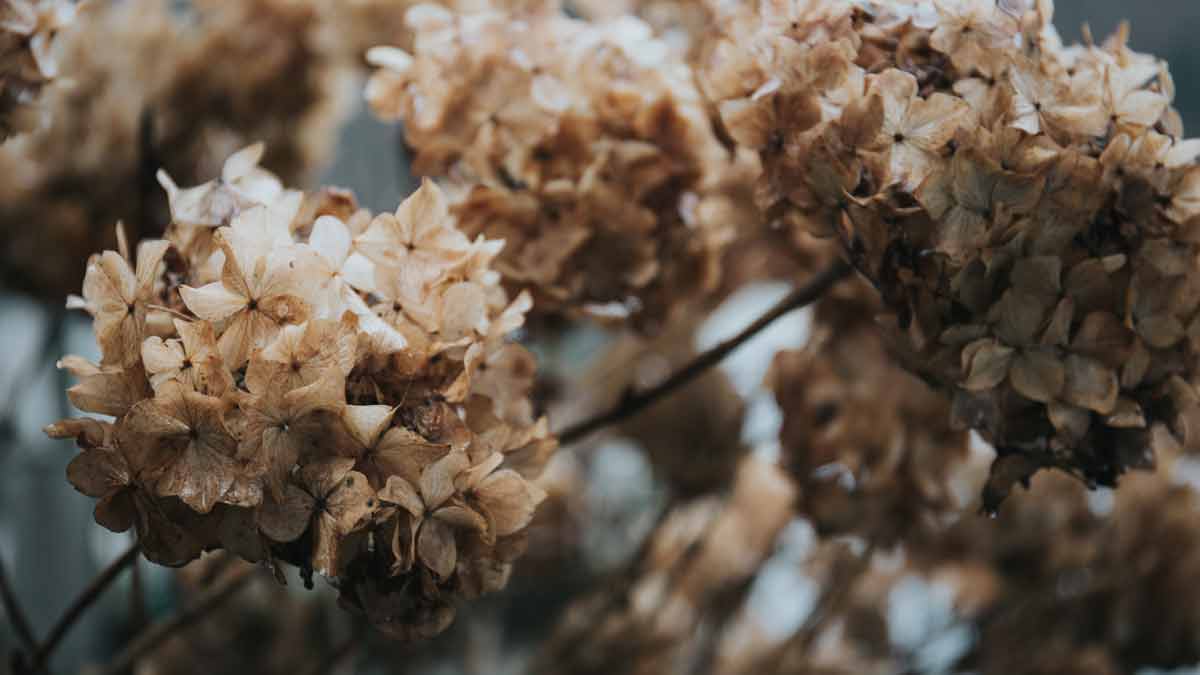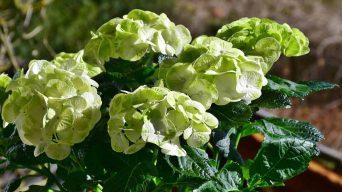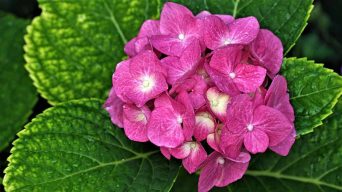Hydrangeas need consistent moisture in the soil to thrive. If the soil is too dry or the plant is not getting enough water, the leaves may droop and turn brown, indicating that it’s underwatered. To revive an underwatered hydrangea, make sure to give it a thorough watering, ensuring that the water reaches the roots and the soil is moistened evenly.
Hydrangea plants are popular for their large, showy flowers, which come in various colors.
While hydrangeas are fairly easy to care for, they can suffer from several problems, including underwatering.
Although underwatering is not as common as overwatering, it can still cause significant damage to your plant.
This article will discuss everything you need to know about underwatered hydrangea plants, including how to identify it, treat it, and prevent it in the future.
Why Is Underwatering a Problem For Hydrangeas?
Underwatering is a common problem with houseplants, and hydrangeas are no exception.
While most plants need to be watered regularly, too much or too little water can be detrimental.
Water is essential for plants because it helps to transport nutrients and minerals from the soil to the plant and create energy and food through photosynthesis.
It also helps to keep the plant cool and provides support.
When a plant is underwatered, it does not get enough water to perform these vital functions.
This can lead to several problems, but it can even kill the plant in severe cases.
How Does Underwatering a Hydrangea Occur?
There are a few different ways that underwatering can occur.
The most common causes are:
Infrequent Watering
One of the most common reasons for underwatering is simply forgetting to water the plant regularly.
This is especially common with new gardeners or those who are forgetful.
If you only water your hydrangea once a week or less, it is likely that the plant is not getting enough water and is suffering from underwatering.
Hydrangeas must be watered at least three times a week and more often in hot weather.
Poor Drainage
Another common cause of underwatering is poor drainage.
Hydrangeas need well-drained soil to thrive; if the soil is too dense or compacted, it can prevent water from reaching the roots.
This can lead to the plant becoming dehydrated and stressed, eventually killing it.
To improve drainage, add organic matter such as compost or peat moss to the soil before planting.
You can also add holes to the bottom of the pot to allow water to drain more easily.
Hot Weather
Hot weather can also cause hydrangeas to suffer from underwatering.
When it is hot outside, the plant will lose water more quickly through evaporation and transpiration.
This means that you will need to water your plant more often to compensate for the loss of water.
If you do not water your plant more often in hot weather, it will become dehydrated and stressed, eventually killing it.
Too Much Sunlight
Too much sunlight can also cause underwatering in hydrangeas. If your plant receives more than six hours of sunlight daily, the soil is likely drying out too quickly.
You can either move the plant to a shadier spot or increase the watering frequency.
If you live in an area with very hot summers, it’s best to grow your hydrangea plant in a spot that receives partial shade.
Incorrect Pot Size
Another common cause of underwatering is using a pot that is too small for the plant.
As plants grow, they need more room to spread out their roots.
If the pot is too small, the roots will become cramped and cannot absorb enough water to hydrate the plant properly.
This can lead to the plant becoming stressed and dehydrated, eventually killing it.
It is essential to choose a pot that is big enough for the plant and regularly checks the roots to ensure they have enough room to grow.
Pest Damage
Pest damage can also cause underwatering in hydrangeas. If your plant is infested with pests, they may damage the roots and prevent the plant from absorbing water.
This can lead to the plant becoming dehydrated and stressed, eventually killing it.
To prevent pest damage, regularly check your plant for pests and treat them with an appropriate pesticide.
Diseases
Diseases can also cause underwatering in hydrangeas. If your plant is infected with a disease, it may damage the roots and prevent the plant from absorbing water.
Common diseases that can cause underwatering include root rot and Pythium.
To prevent disease, regularly check your plant for signs of disease and treat it with an appropriate fungicide.
Compacted Soil
Compacted soil can also cause underwatering in hydrangeas. When the soil is compacted, it prevents water from reaching the roots of the plant.
This can lead to the plant becoming dehydrated and stressed, eventually killing it.
Regularly aerate the soil around your plant to prevent compacted soil and add organic matter such as compost or peat moss.
How To Tell If Your Hydrangea Is Underwatered
It’s essential to catch underwatering early so you can take steps to correct the problem.
If you wait too long, the plant will become stressed and may eventually die.
That’s why it’s essential to know the signs of an underwatered plant.
Signs of an Underwatered Hydrangea
You can look for several signs to tell if your hydrangea is underwatered.
These include:
Drooping Leaves
One of the most common signs of an underwatered plant is drooping leaves.
When a plant is short on water, the leaves will start to droop because it does not receive enough water to support them.
If you see drooping leaves on your hydrangea, it’s a good idea to check the soil to see if it is dry.
If the soil is dry, you must water your plant immediately.
Wilting Leaves
Another common sign of an underwatered plant is wilting leaves.
When a plant is underwatered, the leaves will start to wilt because the plant is losing water faster than it can replace it.
If you see wilting leaves on your hydrangea, checking the soil to see if it is dry is a good idea.
If the soil is dry, you must water your plant immediately.
Yellowing Leaves
Yellowing leaves are a common indicator of an underwatered plant. When a plant doesn’t receive enough water, the leaves of the Hydrangea can turn yellow because they are deprived of essential nutrients.
While yellow leaves can sometimes signal other issues like nutrient deficiencies, it’s a wise practice to examine the soil’s moisture level. If the soil is dry, it’s crucial to water your plant promptly.
Dry or Cracked Soil
One of the best ways to tell if your plant is underwatered is to check the soil.
When the plant does not receive enough water, the soil will dry out and crack.
When the soil has been dry for long periods, it will start to pull away from the sides of the pot.
If you see dry or cracked soil on your hydrangea, it’s a good idea to water your plant immediately.
Brown Spots on the Leaves
Another common sign of an underwatered plant is brown spots on the leaves.
When a plant is not receiving enough water, the leaves will start to turn brown and drop off.
This happens because the plant is losing water faster than it can replace it, and the leaves are starting to dry.
Curling Leaves
Another common sign of an underwatered plant is curling leaves.
When a plant is not receiving enough water, leaves will curl up because they are not receiving the hydration they need.
Although hydrangea curling leaves can also be a sign of other problems, such as heat stress, it’s a good idea to check the soil to see if it is dry.
If the soil is dry, you must water your plant immediately.
Leaf Drop
One of the most serious signs of an underwatered plant is leaf drop.
When a plant is not receiving enough water, the leaves will start to fall off.
This happens because the plant is losing water faster than it can replace it, and the leaves are starting to dry.
If you see leaves dropping on your hydrangea, it’s a good idea to water your plant immediately.
Brown Tips and Edges on the Leaves
Another common sign of an underwatered plant is brown tips and edges on the leaves.
When a plant is not receiving enough water, the leaves will start to turn brown and dry out.
This happens because the plant is losing water faster than it can replace it, and the leaves are starting to dry.
If you see brown tips and edges on your hydrangea, it’s a good idea to water your plant immediately.
Flowers Falling Off
Another common sign of an underwatered plant is flowers falling off.
When a plant does not receive enough water, the flowers will wilt and fall off.
This happens because the plant is losing water faster than it can replace it, and the flowers are starting to dry.
If you see flowers falling off your hydrangea, it’s a good idea to water your plant immediately.
Dry or Wilted Flowers
Another common sign of an underwatered plant is dry or wilted flowers.
When a plant does not receive enough water, the flowers will wilt and fall off.
This happens because the plant is losing water faster than it can replace it, and the flowers are starting to dry.
If you see dry or wilted flowers on your hydrangea, it’s a good idea to water your plant immediately.
Slow Growth
One of the most common signs of an underwatered plant is slow growth.
When a plant does not receive enough water, it will start to grow slowly because it does not receive the nutrients it needs.
If you see that your plant is not growing as fast as it should, it’s a good idea to check the soil to see if it is dry.
If the soil is dry, you must water your plant immediately.
How To Save an Underwatered Hydrangea
Underwatering is a common problem with hydrangeas, but it can be easily fixed.
If you think your plant is underwatered, there are a few things you can do to save it.
1. Water Deeply and Thoroughly
The first thing you need to do is water your plant deeply and thoroughly.
Watering deeply means you should water the plant until the water starts to run out of the bottom of the pot.
This will ensure that the roots are getting enough water.
2. Check the Soil
The next thing you need to do is check the soil.
You should make sure that the soil is moist but not soggy.
If the soil is dry, you must water your plant immediately.
3. Move the Plant to a Shady Area
If the plant is in direct sunlight, you must move it to a shady area.
This will help the plant to conserve water and prevent the leaves from drying out.
4. Move the Plant to a More Humid Area
If the plant is in a dry area, you will need to move it to a more humid area.
This will help the plant to conserve water and prevent the leaves from drying out.
5. Mist the Plant
If the plant is in a dry area, you can also mist the plant with water.
This will help raise the plant’s humidity and prevent the leaves from drying out.
6. Use a Humidity Tray
You can also use a humidity tray if the plant is in a dry area.
This is a tray that you fill with water and then place the pot on top.
The water will evaporate and raise the humidity around the plant.
7. Prune the Plant
If the plant is not growing well, you can prune it.
Remove any dead or dying leaves and stems.
You should also remove any flowers that are falling off.
This will help the plant to focus its energy on new growth.
8. Soak the Plant
You can also soak the plant if the plant is not growing well.
To do this, you must fill a sink or bucket with water and place the plant.
Make sure that the roots are submerged in the water.
Leave the plant for about 30 minutes, then remove it from the water.
9. Repot the Plant
If the plant is root-bound, you will need to repot it.
When the roots of a plant become crowded, the plant will not be able to absorb as much water.
This can lead to the plant becoming underwatered.
To repot the plant, you must remove it from its current pot and then replant it in a larger pot.
10. Be Patient
It can take time for an underwatered plant to recover.
Even if you do everything right, it may take a few days or weeks for the plant to start recovering.
You will need to be patient and wait for the plant to grow again.
How To Prevent Underwatering a Hydrangea
If you’re concerned about underwatering your hydrangea, you can do a few things to prevent it.
Water the Plant Deeply and Regularly
One of the best ways to prevent underwatering is to water the plant deeply and regularly.
This means watering it until the soil is saturated and water begins to run off.
Doing this will help ensure that the roots are getting enough water.
In general, water your hydrangea two to three times a week.
If the weather is particularly hot or dry, you may need to water it more often.
Water in the Morning
It’s best to water your hydrangea in the morning.
This gives the plant time to absorb the water before the heat of the day sets in.
Watering in the evening can also work, but be sure to water early enough, so the plant has time to dry out before nightfall.
Mulch the Soil
Mulching the soil around your hydrangea can also help prevent underwatering.
Mulch helps to hold in moisture and keeps the roots cool.
A layer of mulch two to three inches thick is typically sufficient.
Make sure to keep the mulch away from the base of the plant to prevent rot.
Check the Soil Regularly
Checking the soil regularly is another good way to prevent underwatering.
Stick your finger into the soil to see how moist it is.
If the soil is dry, it’s time to water the plant.
Check the soil before watering, as overwatering can also be a problem.
Use a Watering Can
When watering your hydrangea, using a watering can with a long spout is best.
This will help ensure that the water goes straight to the plant’s roots and doesn’t run off to the sides.
Use a garden hose with a spray attachment if you don’t have a watering can.
Be sure to water slowly and evenly, so the roots have time to absorb the water.
Use the Right Size Pot
When potting your hydrangea, be sure to use a pot that is large enough for the plant.
A pot that is too small will not hold enough water, which can lead to underwatering.
In general, it’s best to choose a pot one size larger than the pot the plant is currently in.
This will give the roots enough room to grow without being too cramped.
Monitor the Weather
Finally, be sure to monitor the weather.
If it’s been particularly hot or dry, your plant may need more water than usual.
Keep an eye on the forecast and adjust your watering schedule accordingly.
Final Thoughts
Hydrangea care is not difficult, but it does require paying attention to the plant’s needs.
You can keep your hydrangea plant healthy and blooming all season long with little effort.
Just be sure to water regularly, especially during hot, dry weather.
And don’t forget to fertilize your plant during the growing season to encourage lush growth and an abundance of flowers.
If you do find your plant is underwatered, don’t despair.
With some quick hydration methods and a little TLC, your plant will return to its old self in no time.







